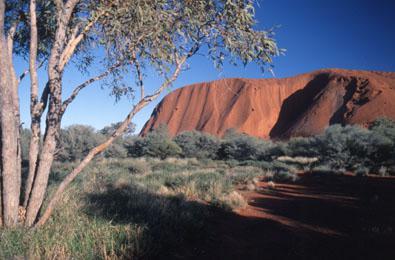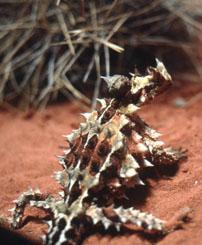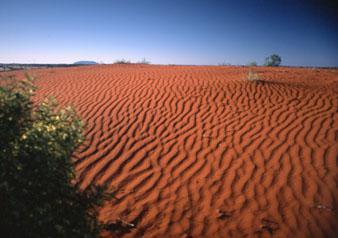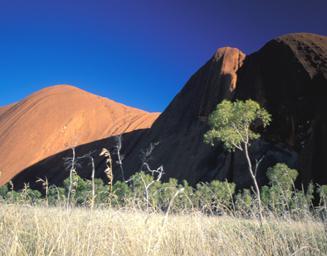(My journal entry from our visit in April 1999)

Uluru, formerly known as Ayers Rock
We have just returned from our Easter vacation trip with a week’s worth of clothes covered in fine red dust acquired in Australia’s “Red Center” where we visited Uluru (formerly known as Ayers Rock), in Uluru and Kata Tjuta National Park, and Alice Springs, the largest town in the heart of Australia’s enormous desert interior and the center of life in the outback. In the desert, daytime temperatures can easily rise to 110 degrees or more and in winter it goes below freezing at night, but we were lucky to have beautiful weather in the seventies. In the morning, though, it was so cold that I had to put on my thermal underwear!A Desert Oasis

Thorny Devil Lizard
As in most deserts, one would think that nothing could live in such a harsh environment, but we saw a surprising variety of plant and animal life, especially near sources of water. Actually, the land around Uluru was green and flowering due to rains several weeks ago. This trip was also our first real exposure to Aboriginal life and we learned how people have lived and survived in this region for 70,000 years. About half of the land in the Northern Territory belongs to the Aboriginal Land Trust, the equivalent of America’s Indian Reservations, and most of Australia’s Aborigines live in this region.Uluru as a Tourist Destination

Spinifex, typical grass of the Australian desert
We flew to Uluru on Thursday, arriving about noon at our hotel in the resort village of Yulara. Until the 1970's the only way to visit Uluru (then called Ayers Rock) was to drive there and camp or stay at a small motel, both located right at the base of the rock. (You may have seen a movie called Cry in the Dark starring Meryl Streep. It was based on the true story of a couple camping at the rock whose baby was supposedly stolen by a dingo.) As Uluru became an increasingly popular tourist destination (currently 400,000 people visit each year) it was decided to move all the accommodation facilities outside the park boundary and Yulara was built. About the same time the government was under increasing pressure from the Aborigines, who regard Uluru as a sacred site, to return the national park to them. The Hand Back, as it is called, finally happened in 1985 with the agreement that tourists would continue to be allowed to visit.Mingi

Sand dune with Uluru in the distance
We didn't climb Uluru. The Aborigines don't like having people climb it although they don't stop them. The Aborigines call the people who climb the rock Mingi, which means "ants" and that's exactly what they look like when you see them from a distance. The more eco-minded tour companies discourage climbing Uluru. Not only is it disrespectful for the Aborigines who consider the rock sacred but it is wearing down the rock. In any case, Art doesn't like high places so he was easily convinced that we didn't want to climb. We decided that we'd much more enjoy a walk around the base of the rock.Sunrise Walk Around the Rock

View of Uluru from walk around the base of the rock
The next morning we got up at 5:30 to meet our tour guide for a sunrise breakfast walk around the base of the rock, a distance of about ten kilometers. This was a small group eco-tour and this time we were nearly alone to enjoy the lighting of the rock at dawn. At the same time we had the double pleasure of seeing the moon set behind the rock.In the course of the walk we were introduced to desert plants, saw lots of birds (including our first sighting of zebra finches in the wild) and heard some of the aboriginal stories associated with the Rock. We had chances to try “bush tucker” (native edible foods) including a tiny red fruit called the bush plum and the so-called bush banana, which is banana shaped but more like eating the inside of a milkweed pod.
Kata Tjuta
Our outing the next day was a hike and sunset barbecue at Kata Tjuta, an equally impressive but less well known rocky outcrop nearby. The Aboriginal name, Kata Tjuta, means stone heads and they do look like giant heads piled on the horizon. As we returned after dark, we saw an owl and a dingo in the headlights of the bus. Overhead, the sky was brilliant with the moon and Southern constellations.
On Sunday morning, after five days in the park, we flew from Ayers Rock to Alice Springs, a distance of about 300 miles.
[We were so inspired by this visit to Uluru that we returned three years later to take more photos and to research my book Uluru: Australia’s Aboriginal Heart (Clarion, 2003.)]
Accommodations at Yulara: On this trip we stayed at the Desert Gardens Hotel. On our subsequent trip, when we researched my book, we stayed at the Emu Walk Apartments.
